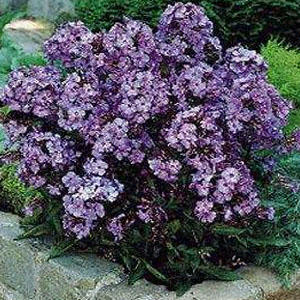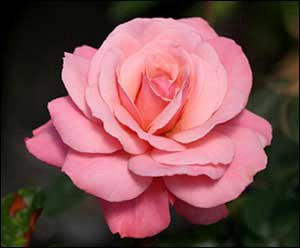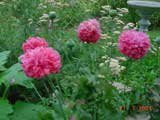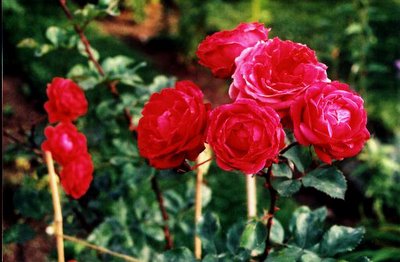A Sample of Osgoode Public Garden Plants
______________________________________________
A much sought-after annual flower, though hard to find, these sumptuous, richlycoloured heirlooms resemble double peonies. Huge 5" blooms in lavender, red, white and pink. Leaves are smooth and lettuce-like. Ht. 3'-4'.

Brought to England from Patagonia in 1834, this drought tolerant plant will flower from midsummer into fall. Its sprawling habit and attractiveness to butterflies and hummingbirds make it a must have in the cottage garden. Lilac purple clusters of .25” flowers sit atop stiff branching stems that can grow to 6’. Thrives in full sun in well drained garden soil. It is a reliable self-seeder without being invasive.
Deep rose red flowers that do not fade, compact growth, blooms most of the summer, the best red! Summer Sun
 Hemerocallis ‘Glacier Bay’Awarded!
Hemerocallis ‘Glacier Bay’Awarded!
Creamy white flowers with green eye, ruffled gold edges, mid season, repeats, evergreen, tetraploid Summer Sun / Partial shade
 Hemerocallis ‘Rosy Returns’ PP9779
Hemerocallis ‘Rosy Returns’ PP9779
First ever-blooming pink! Deep pink with rose eyezone, yellow throat, 9 to 12 buds on each stem, dwarf habit, dormant, diploid. An outstanding selection bred by Dr. Darrel Apps, one of only a small handful of truly everblooming Daylilies available to gardeners in northern regions. This dwarf variety has large (4") bright rose flowers with a deeper pink eye and a yellow throat. Repeats constantly from June to frost. Diploid. Winter dormant. Spent flower stems can be trimmed back after all the buds have finished. Remove old foliage in late fall. Flowers are edible. May well prove to be hardy in Zone 2. Summer / Fall Sun / Partial shade
A wonderful form with silver-grey foliage edged in white. Tall spikes of lavender blue flowers. June to August. Sun
 Chamaecyparis pisifera filifera 'Sungold'
Chamaecyparis pisifera filifera 'Sungold' Growth Habit: Flat round habit
USDA Zone: 3-8
Exposure: Full sun
Growing Conditions: well-drained soils
Comments: Thread-like foliage is yellow against green. Twice as high as wide.

Growth Habit: irregular low mound
USDA Zone: 4-7
Exposure: full sun
Growing Conditions: well-drained soil
Comments: Silver-blue foliage.

A Paradise Garden Five Star Peony
Mid, 30”, Semi-Double
One glance at this beauty will confirm why it was a Gold Medal winner. Gorgeous deep rose semi-double blooms.

Lavender blue with white eyes and tiny red centers.
One of the finest hybrid phlox varieties available. Garden Phlox or "Flame Flowers", bloom in profusion with huge 5-6 inch flower heads all summer. The flowers are fragrant and showy, with brilliant non fading colors. Growing 2-3 feet tall, they are excellent for perennial borders, corners and for cut flowers. The foliage is dense and compact with deep green, lance shaped leaves with prominent veins.
Zone: 3-8

Red blend [ARS rb] blooms. Tea fragrance. 7 petals. Average diameter 3.5". Single bloom form. Repeats its bloom again later in the season.
Height of 24" to 42" (60 to 105 cm). Width of 36". (90 cm).
Zone 4 thru 9. Shade Tolerant. Disease resistant. A landscape shrub rose. Excellent disease resistance to blackspot. The blooming cycle is believed to be one of the longest observed to date for a rose plant...
It has great hardiness and disease resistance, is low maintenance and very free blooming.
Rose "Alexander MacKenzie" - Explorer Series
Alexander MacKenzie is a tall, upright, vigorous shrub introduced in 1985. The plant reaches a height of 1.5 - 2.0 m and has a diameter of 1.2 - 1.5 m in Ottawa. It is winter-hardy, flowers recurrently, and is highly resistant to blackspot and powdery mildew.
The deep red, cup-shaped flowers, produced in clusters of 6 - 12, have an average diameter of 6 - 7 cm and 40 - 50 petals. The flowers closely resemble those of a grandiflora or hybrid tea rose, but the plant has the distinct advantage of being much hardier. The rose propagates easily from softwood stem cuttings.
This selection has been tested at Ottawa since 1972 and at other test locations in Canada, since 1978. It survives the winters in zone 3b without protection, but needs some pruning of deadwood in the spring. However, REPLOQ test results showed that this rose can survive in zone 2b but cane dieback in zones 2b to5b, can be to snow or soil level depending upon the hardiness of the winter. Spring pruning is necessary.
Alexander MacKenzie was obtained from a cross between the grandiflora Queen Elizabeth and a hardy seedling descended from a cross between the shrubs Red Dawn and Suzanne.

Rose "Sexy Rexy"
(Plant Patent #6713, Var: MACrexy) – This represents one of the great milestones in Sam McGredy’s career as an innovator of roses. Full clear pink blooms sometimes borne in huge clusters that virtually cover the plant. Tall for a floribunda and nearly disease free and can be used as a hedge or shrub where spraying is impractical. If you can find it beneath all that bloom, the foliage is shiny dark green. Survives even the nastiest of winters.

Grass (Molinia caerulea arundinacea) 'Skyracer' or Skyracer Tall Moor Grass
'Skyracer' is the standard cultivar of Tall Moor Grass with a more vigorous growth rate than the subspecies, maturing at eight feet tall when in flower. A dark background is useful to display the thin flowering and fruiting stalks.

Willow 'Hakuro-nishiki'
This is a small tree or large shrub suitable for most gardens, provided they receive fairly plentiful sun. Elegant, with long, slightly drooping branches when it reaches maturity, in its earlier years Salix integra 'Hakuro-nishiki' is enjoyably boisterous. The young branches develop in all directions, creating a starburst of colour and interest. Eventually they start to bend downwards under their own weight. In terms of visual benefits at other times of the year, expect delicate catkins along the stems from early April, quickly followed by pairs of attractively marked, oblong, bright green leaves. Although willows are often associated with waterside situations, 'Hakuro-nishiki' will also thrive on drier soils.

Artemisia lactiflora 'Guizho'
White Mugwort
A very showy ornamental that is quite different from other Artemisia. This is a statuesque perennial growing 4-5' tall with dramatic reddish-brown stems and ferny, green-black foliage. Late in the season it is set with large creamy-white plumes which provide a dramatic contrast to the foliage. An excellent back of the border perennial. Makes a good cut flower. Can be grown in sun or part shade and prefers a moist site. Zn 3 - 9
 Stachys Grandiflora (Big Betony)
Stachys Grandiflora (Big Betony)It's hard to understand why more people don't grow this plant today. It may have been a more popular selection 50 years ago. While it's not spectacular it is an attractive plant even when not in bloom. The flowers last a long time and will fit into many colour schemes without clashing and it seems to be very hardy. Plant in well-drained, garden soil in full sun. Space 12-18" apart. Requires only moderate watering. Divide only when necessary. Grows 12-24" tall. Flowers late spring to summer. Hardy in Zones 5-8.

Larkspur, Consolida ambigua
One of the most spectacular reseeding annuals is larkspur. Larkspur, Consolida ambigua, is known for its tall spikes of blue, lavender, purple, pink or white flowers. Bicolor flowers occur occasionally as well. Flowering annuals that re-seed and return year after year can be as valuable as perennial flowers to the garden. There is something magical about plants that like your garden so well that they choose to come back each year for another visit. In addition to convenience and economy, reseeding annuals often add a charm and special character since they frequently come up in places where we may not have planted them, adding spontaneity to the garden.
Larkspur comes from the genus name "Delphinium", which is from the Greek word Delphin (a dolphin). It was given to this genus because the buds were held to resemble a dolphin. Shakespeare mentions the plant under the name of Lark's Heel.

Aubrieta
Aubrieta makes a colorful splash in early spring. It is a mat-forming, evergreen perennial, and its flowers - in shades of purple (such as Purple Cascade) and blue (such as J.S. Baker) - cover the plant. It grows well in rockeries, at the top of a retaining wall or as an edging plant along a path.
 Traditionally, lilac experts bred plants within one species, or at most, crossed two species. Today, many species can be combined to produce more complex hybrids. 'Miss Canada' is a complex hybrid resulting from crosses involving three species.
Traditionally, lilac experts bred plants within one species, or at most, crossed two species. Today, many species can be combined to produce more complex hybrids. 'Miss Canada' is a complex hybrid resulting from crosses involving three species.
Tiger Eyes Cutleaf Staghorn Sumac should be in your garden center this spring. Its new growth is a vivid chartreuse, quickly changing to a bright-yellow summer color. Its leaf stems are a fuzzy purple-pink and form a dramatic contrast with lemon-lime foliage. The branches angle upward, while the deeply cut leaflets drape downward, giving the whole plant a rather elegant, oriental look. In fall, the colors turn to a combination of orange, yellow and intense scarlet. It reaches a manageable height of 6 ft. and spreads slowly.









 Baptisia
Baptisia

1 Comments:
I don't know why you say that, but this's a good website, I bought some from here in the NFL star,they have good service attitude, the quality are ok, you know!
Wholesale Jerseys
Cheap NFL Jerseys
Post a Comment
<< Home